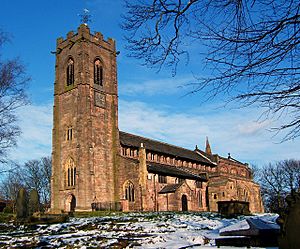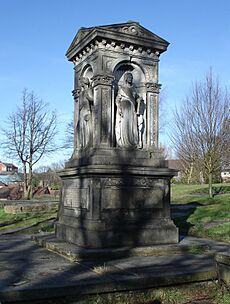Church of St Mary the Virgin, Prestwich facts for kids
Quick facts for kids Parish Church of St Mary the Virgin, Prestwich |
|
|---|---|

St Mary's from the southwest
|
|
| Lua error in Module:Location_map at line 420: attempt to index field 'wikibase' (a nil value). | |
| OS grid reference | SD 811,037 |
| Location | Church Lane Prestwich Greater Manchester |
| Country | England |
| Denomination | Anglican |
| Website | St Mary's Church Official Page: http://www.stmarysprestwich.org |
| History | |
| Status | Parish church |
| Dedication | Virgin Mary |
| Architecture | |
| Functional status | Active |
| Heritage designation | Grade I |
| Designated | 30 June 1966 |
| Architect(s) | Paley, Austin and Paley (1888–89 alterations) |
| Architectural type | Church |
| Style | Gothic Gothic Revival |
| Administration | |
| Parish | Prestwich |
| Deanery | Radcliffe and Prestwich |
| Archdeaconry | Bolton |
| Diocese | Manchester |
| Province | York |
The Church of St Mary the Virgin is a beautiful old church located on Church Lane in Prestwich, Greater Manchester, England. It's an active Anglican church, meaning it's part of the Church of England. This church is very important and is listed as a Grade I building, which is the highest level of protection for historic buildings in England. Experts like Pevsner have called it a "major church" because of its history and design.
Contents
History of St Mary's Church
Even though Prestwich isn't mentioned in the Domesday Book (a famous survey from 1086), there's proof that a church has stood on this spot since at least the year 1200.
- Around 1500, the church's tall tower was built by the 1st Earl of Derby.
- The main part of the church was rebuilt in the early 1500s.
- Over the centuries, different parts of the church were updated. For example, the south porch was rebuilt in 1756.
- In the late 1800s, architects Paley, Austin and Paley made big changes, rebuilding chapels and the chancel (the area around the altar).
- More recently, in 1959, some galleries inside the church were removed.
Architecture of the Church
Let's explore what the church looks like, both inside and out!
Outside the Church
The church is built from red sandstone and has stone slate roofs. It has a long main area called a nave with five sections, and a chancel (the part near the altar) with three sections. Both have a clerestory, which is a row of windows high up to let in light.
- There are also side sections called aisles, and porches on the north and south sides.
- The west tower is 86 feet (about 26 meters) tall. It has strong buttresses (supports) at each corner.
- You can see clock faces on the north, south, and east sides of the tower. Records show there was a clock here as early as 1656!
- The top of the tower has openings for bells and a battlement (a wall with gaps) around the top. It's topped with a pyramid-shaped roof and a weathervane.
- The windows around the church are different styles, some with tracery (stone patterns) and some without. The large east window of the chancel has seven lights and beautiful Perpendicular tracery.
Inside the Church
Inside, the main arches are supported by tall, eight-sided piers (columns) that mostly don't have fancy tops (capitals).
- The roof is coffered (divided into sunken panels) and has carved bosses (decorative carvings where ribs meet). Even though it's been repaired a lot, some parts are still from the 1500s!
- The floor in the chancel is made of colorful marble.
- The stone reredos (a screen behind the altar) is a memorial to a child who sadly passed away in 1863.
- Many of the church's features, like the altar rails, stalls, screen, and pulpit, were designed by the architects Paley, Austin and Paley.
- There's a special chandelier given to the church in 1701. It has an eagle and child design, which is the symbol of the Earls of Derby.
- The church has many beautiful stained glass windows. The large east window has glass from 1861. Other windows were added later, with designs by different artists like Ward and Hughes, Clayton and Bell, and Shrigley and Hunt.
- You'll also find monuments inside, including a very fine one from 1833 dedicated to a former rector (church leader), Rev'd James Lyon, who served the church for 50 years. There are also memorials to important local families.
Organ and Bells
The church has had several organs over the years.
- The first organ was built in 1825.
- In 1889, a new organ was installed, costing £1,000 (a lot of money back then!).
- This was replaced in 1901, and then again in 1964 by an organ from J. W. Walker, which used some parts from the older organ.
- In 2006, this organ was restored and rebuilt by Principal Pipe Organs of York.
The church also has a set of bells.
- Originally, there were four bells.
- In 1721, they were recast into five bells, and a sixth was added.
- In the 20th century, these were replaced by a ring of eight bells, all made by John Taylor & Co. Two were cast in 1910, and the rest in 1919.
- In 1999, for the Millennium celebration, special hammers were added to the bells so they could ring automatically.
Churchyard
The churchyard has been around since the 1300s, but it has been made larger many times over the years.
- A special part of the churchyard holds the graves of over 5,000 people who were residents of the Prestwich County Asylum, a large hospital that was nearby. These burials took place between 1851 and 1968.
- Most of these graves are unmarked, but in 2006, a memorial was put up to remember these individuals. It's made of ruby grey Welsh slate.
Notable Monuments and Graves
The churchyard is home to several interesting monuments and graves.
- One important monument is to John Brooks (1788–1849), a successful businessman and a leader in the Anti-Corn Law League. This monument was sculpted by John Thomas and cost a lot of money. It features four carved female figures representing "Industry," "Commerce," "Charity," and "Integrity." The figure of "Charity" was even shown at the famous Great Exhibition in 1851!
- The churchyard also contains 48 war graves for service members who died in World War I (29 graves) and World War II (19 graves). These include soldiers, sailors, and air force personnel from many different regiments and corps.
- Many other notable people are buried here, including:
- Sir William Fairbairn, a famous engineer.
- Sir William Mather, another important engineer.
- William Sturgeon, an electrical engineer who invented the world's first electromagnet and the first practical electric motor. His grave slab is simple, showing that he lived a modest life despite his amazing inventions.
- Three well-known botanists (plant scientists): Richard Buxton, John Horsefield, and James Percival. John Horsefield's tomb has detailed carvings that show his life and work, including a special flower he helped create.
- There are also several very old grave slabs from the 1600s and 1700s that are still readable, which is quite rare! Some of these show how family names changed over time.
Other Churchyard Structures
Besides the graves, the churchyard has other historic features:
- Old gate piers and boundary walls from the 1800s.
- An 18th-century mounting block, which was used to help people get onto horses.
- A sundial from the 1700s.
- An old hearse house (where a funeral carriage was kept) from 1801, which still has many original features.
- A very unusual triangular stone from 1827 with an inscription asking people to "keep off the grass" because the owner had spent money improving the roads to the church!
See also
- List of churches in Greater Manchester
- Grade I listed churches in Greater Manchester
- Grade I listed buildings in Greater Manchester
- Listed buildings in Prestwich
- List of works by Paley, Austin and Paley
- List of ecclesiastical works by Paley and Austin


